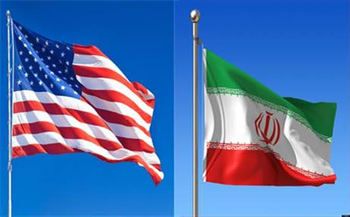
Publisher:
Bonnie King
CONTACT:
Newsroom@Salem-news.com
Advertising:
Adsales@Salem-news.com

~Truth~
~Justice~
~Peace~
TJP
Feb-01-2020 14:05

 TweetFollow @OregonNews
TweetFollow @OregonNews
U.S.-Iran Relations: From Mosaddegh to Trump
Ralph E. Stone, Salem-News.comDiplomacy with Iran is much more productive than sabre-rattling
 U.S. and Iranian flags (image from Speemedia.com) |
(SAN FRANCISCO, Calif.) - Introduction
In November 2002, my wife and I took a 16-day tour of Iran. We visited Tehran, Shiraz, Kerman, Yazd, Esfahan, Persepolis, and Bam. (Tragically, Bam was severely damaged a year later in an earthquake, killing over 26,000 and injuring more than 30,000 others.)
We walked around without fear; everyone was extremely friendly and curious about us, and about America. We have found in our many travels that it is usually U.S. foreign policy, not individual Americans, that many foreigners object to.
Background
Why did we visit Iran? Because according to a 2015 study, there are 1.8 billion Muslims in the world, representing about 24.1% of the world’s population. Most Muslims are either of two denominations: Sunni (80–85%, roughly 1.5 billion people) or Shia (15-20%, roughly 240–340 million people).
Although Shiites are the majority in Iran, they make up a minority in the rest of the Muslim world. Shiites believe that Ali, Mohammad’s first cousin and son-in-law, succeeded Mohammad at his death in AD 632, because that’s what the Prophet decreed.
The Sunnis believe that after the Prophet died, the leader must be selected in the pre-Islamic way, i.e., through consensus among the community’s elders, and do not recognize Ali as the Prophet’s successor.
Not all Muslims are Arabs and not all Arabs are Muslims. Only about 20% of practicing Muslims live in Arab countries. However, Iranians prefer not to be called Arabs. They are Persians. The Persian language is Indo-European; it is barely related to Arabic. The official language of Iran is Persian (Farsi).
The country’s economic system is extremely inefficient largely because of corruption and mismanagement. Eighty percent of the economy is controlled by the government. The constitution mandates that the economy be managed according to Islamic principles, but nobody seems to know what that means. Of course, international sanction have exacerbated Iran’s troubled economy.
The population of the country is about 81million with 60% of the population under 30. The unemployment rate for the 15 to 24 age group is 28.6%. This age group is too young to remember the Shah or the Islamic Revolution. They want more freedom and more fun.
Thus, we feel it is important to try to understand this religion and countries with a Muslim majority, especially since this is one of the world’s current hotspot. We have also visited Syria, Jordan, Morocco, Egypt, Turkey, and Indonesia, as well as Israel.
Why U.S.-Iran Relations are Strained
- In 1951, Mohammad Mosaddegh was appointed the Prime Minister of Iran. He nationalized Iran’s petroleum industry much to the dismay of Western interests. As a result, he was deposed in a 1953 coup d’état, a CIA and British M-16 covert operation. This was the first time the U.S. had participated in the overthrow of a foreign government during the Cold War. The U.S. installed Shah Mohammad Reza Pahlavi as Iran’s leader.
- In 1979, Iran’s monarchy under the Shah was overthrown and replaced with an Islamic republic under Ayatollah Ruhollah Khomeini (1902-1989), the leader of the revolution. The Islamic Revolution is still ongoing, trying to balance Islamic principles with democratic principles.
- On November 4, 1979, fifty-two American diplomats and citizens were held hostage for 444 days, after a group of Iranian college students belonging to the Muslim Student Followers of the Imam’s Line — supporters of the Iranian Revolution — took over the U.S. Embassy in Tehran followed by an ill-fated rescue attempt. You can still see anti-American graffiti on the embassy walls.
- In September 1980, Iraq hoping to take advantage of Iran’s post-revolutionary chaos, invaded Iran. The U.S., Britain, the Soviet Union, France, and most Arab countries provided political and logistic support for Iraq, while Iran was largely isolated. An estimated 500,000 Iraqi and Iranian soldiers died in addition to a smaller number of civilians. The end of the war resulted in neither reparations nor border changes.
In Tehran, we saw many murals depicting men who died in the Islamic Revolution of 1979 and the Iran–Iraq war of 1980–1988. - In July 1988, an Iranian airliner was shot down by the missile cruiser USS Vincennes over the Strait of Hormuz, killing all 290 people on board. The passenger plane, which was in Iranian airspace, had been incorrectly identified as a fighter jet. Iran claimed the act was intentional and sued the U.S.; the U.S. ultimately agreed to pay $61.8 million to the victims’ families, and Iran dropped its suit.
- In 2015, the Obama administration signed a nuclear agreement with Iran whereby Iran’s uranium stockpile would be reduced by 98% to 300 kg (660 lbs) for 15 years at Fordo, no enrichment would be permitted for 15 years, and the underground facility would be converted into a nuclear, physics and technology centre.
- In May 2018, Trump formally withdrew from the nuclear agreement — even though Iran was abiding by it — partly because the agreement did not address Iran’s support for armed groups across the region and its ballistic missile program, and reintroduced “maximum” sanctions on Iran’s economy. The nuclear deal with Iran was thought to be a foundation for further negotiation on other areas of concern. Now, however, we have no nuclear deal and prospects for further negotiations with Iran are dim.
- On January 3, 2020, Maj. Gen. Qassem Suleimani, Iran’s top security and intelligence commander and leader of the powerful Quds Force of Iran’s Islamic Revolutionary Guards Corps, was assassinated by the U.S.. President Trump authorized the strike without notifying Congress or our allies.
Gen. Soleimani was an accredited combatant general of a foreign state which the world – including the U.S. – recognizes. He had traveled to Iraq on a diplomatic visa as a guest of the Iraqi government, a U.S. ally. Iran responded with ballistic missile attacks of U.S. bases in Iraq. No one was killed, but numerous personnel suffered concussions. Iran later inadvertently shot down an airplane killing all 176 passengers, an unintended consequence of the assassination.
Iran says it will pursue war-crimes charges against President Trump at the International Criminal Court in the Hague over the assassination of Gen. Soleimani. - Iran is incensed that the U.S. favors Israel in the Israeli-Palestinian conflict.
- Iran helps arm, train, and otherwise supports numerous insurgent and rebel groups in Afghanistan, Iraq, Syria, Yemen, the Palestinian territories and other areas, and its activities are part of why the U.S. has long labeled Iran the “world’s leading sponsor of terrorism.” Iran is suspected of complicity in the 1983 bombings of the U.S. embassy in Beirut that killed more than 60 people; and later that year, bombing a U.S. military compound killing 241 American servicemen; supporting the Lebanese Shiite militia Hezbollah.
Conclusion
Clearly, the U.S. must attempt sincere diplomacy with Iran. After all, this is much more productive than sabre-rattling. But with all this historical baggage, the pulling out of the nuclear agreement with Iran, and the assassination of Gen. Soleimani, the task will not be an easy one.
Articles for January 31, 2020 | Articles for February 1, 2020 |


googlec507860f6901db00.html


Quick Links
DINING
Willamette UniversityGoudy Commons Cafe
Dine on the Queen
Willamette Queen Sternwheeler
MUST SEE SALEM
Oregon Capitol ToursCapitol History Gateway
Willamette River Ride
Willamette Queen Sternwheeler
Historic Home Tours:
Deepwood Museum
The Bush House
Gaiety Hollow Garden
AUCTIONS - APPRAISALS
Auction Masters & AppraisalsCONSTRUCTION SERVICES
Roofing and ContractingSheridan, Ore.
ONLINE SHOPPING
Special Occasion DressesAdvertise with Salem-News
Contact:AdSales@Salem-News.com
Terms of Service | Privacy Policy
All comments and messages are approved by people and self promotional links or unacceptable comments are denied.
[Return to Top]
©2026 Salem-News.com. All opinions expressed in this article are those of the author and do not necessarily reflect those of Salem-News.com.